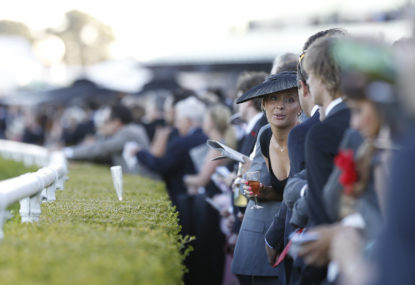TWO GOOD! Zahra wins back-to-back Melbourne Cups on Without a Fight as three horses pull up lame
Without a Fight completed the rare Caulfield Cup-Melbourne Cup double on Tuesday as star jockey Mark Zahra went back-to-back in the big one after…

After years of playing second fiddle to Melbourne, Sydney’s extravagant concept, The Championships, has become a fierce battleground among owners and trainers jostling for a shot at glory (read: an epic payday).
The most notable change to the Sydney autumn carnival is the increase in prize money for the Queen Elizabeth Stakes from $500,000 to $4,000,000.
The change has got every owner talking. All of a sudden, horses which had never even been in consideration for the race are scheming plots to force their way into the final field.
Run over 2000m under weight-for-age conditions at Royal Randwick, the Queen Elizabeth Stakes has seemingly become the pinnacle of Australian racing with bigger prize money than the Cox Plate and more fanfare around the race.
Although the second richest race in Australian racing behind the Melbourne Cup, the weight-for-age status of the Queen Elizabeth has opened up a whole new sector of entrants. With three-year-olds capable of making the final field and assigned a weight concession, the race truly rivals France’s Prix de l’Arc de Triomphe.
It’s held six months after the Cox Plate, when three-year-olds are significantly more developed and a much greater number of them will be entered in the race which can immortalise them.
Earlier in the week, John O’Shea announced an odd campaign for three-year-old Savvy Nature, who was the favourite in the VRC Derby but finished 14th.
For a horse like Savvy Nature, the traditional autumn campaign would encompass the three-year-old Triple Crown – Randwick Guineas, Rosehill Guineas and Australian Derby worth a combined $3.1 million.
But why chase $3.1 million when you can send your best three-year-old to the $3 million Doncaster Mile and $4million Queen Elizabeth Stakes? Which is exactly what O’Shea will be doing with Savvy Nature.
The three-year-old’s campaign will include racing against his age group, stepping up to open handicap class and culminating in a weight-for-age event.
The Championships has thrown all conventional wisdom out the door, but do you want to know the best thing?
The Queen Elizabeth Stakes will do something the Melbourne Cup can’t do – create a field where only the best horses will start.
Horses headed for the Queen Elizabeth Stakes will comes through three main races – the BMW (2400m, weight-for-age), Doncaster Mile (1600m, handicap) and Rosehill Guineas (2000m, three-year-olds).
In recent years, there has been almost no interest from three-year-olds to take the Queen Elizabeth test. The 2013 edition featured one three-year old (It’s A Dundeel), the 2012 none and 2011 one (Retrieve).
Only one three-year-old has ever won the race and that was Intergaze in 1997.
The 2000m mark is ideal for horses to either step up or down in distance without drastically altering their training regimes, while the weight-for-age aspect opens the race up to the three-year-olds.
Unlike the Cox Plate, the three-year-olds will only get a minor weight concession in the Queen Elizabeth, with colts and geldings assigned 6kg more than what they would carry in the Cox Plate.
The field will be headlined by horses who will essentially have never met before. Melbourne Cup winner Fiorente leads the market from It’s A Dundeel, while the allure of the race has led Boban to progress from handicap racing and youngsters Guelph and Savvy Nature to exit their age group.
The only thing the Queen Elizabeth has failed to do is attract international attention like the Melbourne Cup does year after year.
The major issue with Sydney luring international talent is the timing of the race three weeks after the Dubai World Cup – also run over 2000m under weight-for-age conditions but worth $10 million.
Due to Australia’s strict quarantine conditions, the three weeks in between races is not enough time for any horses to compete in both races. This is why European, American and Asian horses will see the Dubai World Cup as more favourable.
One distinguishing feature between the races though is that the Dubai World Cup is run at Meydan on their synthetic tapeta surface, whereas the Queen Elizabeth is run on traditional turf.
Hong Kong Cup (2000m, weight-for-age) winner Akeed Mofeed would have been a major pull for the Queen Elizabeth but trainer Richard Gibson eventually opted for Dubai.
“In the end, the quarantine situation with Australia made the decision for us,” he said.
The good news though, is most of the prize money will stay in Australia which is something the Melbourne Cup has failed to achieve in recent years.
The first revised edition hasn’t even be run yet, but the Queen Elizabeth Stakes now has the Cox Plate firmly on the back foot as the pinnacle of Australian racing.